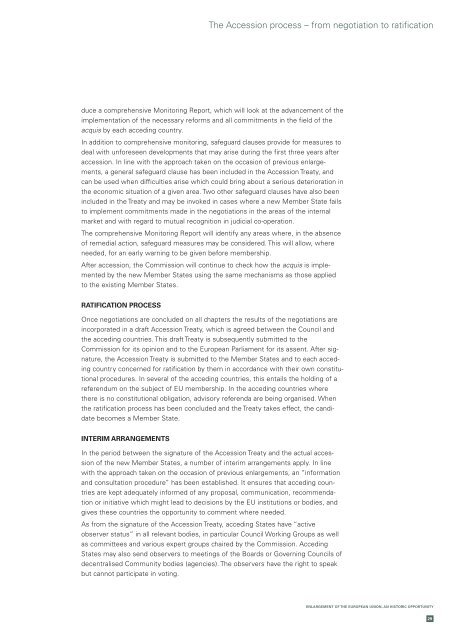European Union Enlargement - An historic opportunity
European Union Enlargement - An historic opportunity
European Union Enlargement - An historic opportunity
You also want an ePaper? Increase the reach of your titles
YUMPU automatically turns print PDFs into web optimized ePapers that Google loves.
The Accession process – from negotiation to ratification<br />
duce a comprehensive Monitoring Report, which will look at the advancement of the<br />
implementation of the necessary reforms and all commitments in the field of the<br />
acquis by each acceding country.<br />
In addition to comprehensive monitoring, safeguard clauses provide for measures to<br />
deal with unforeseen developments that may arise during the first three years after<br />
accession. In line with the approach taken on the occasion of previous enlargements,<br />
a general safeguard clause has been included in the Accession Treaty, and<br />
can be used when difficulties arise which could bring about a serious deterioration in<br />
the economic situation of a given area. Two other safeguard clauses have also been<br />
included in the Treaty and may be invoked in cases where a new Member State fails<br />
to implement commitments made in the negotiations in the areas of the internal<br />
market and with regard to mutual recognition in judicial co-operation.<br />
The comprehensive Monitoring Report will identify any areas where, in the absence<br />
of remedial action, safeguard measures may be considered. This will allow, where<br />
needed, for an early warning to be given before membership.<br />
After accession, the Commission will continue to check how the acquis is implemented<br />
by the new Member States using the same mechanisms as those applied<br />
to the existing Member States.<br />
RATIFICATION PROCESS<br />
Once negotiations are concluded on all chapters the results of the negotiations are<br />
incorporated in a draft Accession Treaty, which is agreed between the Council and<br />
the acceding countries. This draft Treaty is subsequently submitted to the<br />
Commission for its opinion and to the <strong>European</strong> Parliament for its assent. After signature,<br />
the Accession Treaty is submitted to the Member States and to each acceding<br />
country concerned for ratification by them in accordance with their own constitutional<br />
procedures. In several of the acceding countries, this entails the holding of a<br />
referendum on the subject of EU membership. In the acceding countries where<br />
there is no constitutional obligation, advisory referenda are being organised. When<br />
the ratification process has been concluded and the Treaty takes effect, the candidate<br />
becomes a Member State.<br />
INTERIM ARRANGEMENTS<br />
In the period between the signature of the Accession Treaty and the actual accession<br />
of the new Member States, a number of interim arrangements apply. In line<br />
with the approach taken on the occasion of previous enlargements, an “information<br />
and consultation procedure” has been established. It ensures that acceding countries<br />
are kept adequately informed of any proposal, communication, recommendation<br />
or initiative which might lead to decisions by the EU institutions or bodies, and<br />
gives these countries the <strong>opportunity</strong> to comment where needed.<br />
As from the signature of the Accession Treaty, acceding States have “active<br />
observer status” in all relevant bodies, in particular Council Working Groups as well<br />
as committees and various expert groups chaired by the Commission. Acceding<br />
States may also send observers to meetings of the Boards or Governing Councils of<br />
decentralised Community bodies (agencies). The observers have the right to speak<br />
but cannot participate in voting.<br />
ENLARGEMENT OF THE EUROPEAN UNION, AN HISTORIC OPPORTUNITY<br />
29

















